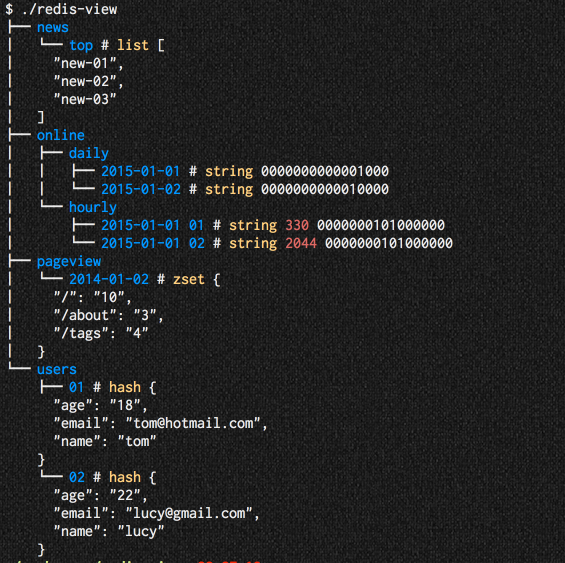rtreego
A library for efficiently storing and querying spatial data in the Go programming language.
About
The R-tree is a popular data structure for efficiently storing and querying spatial objects; one common use is implementing geospatial indexes in database management systems. Both bounding-box queries and k-nearest-neighbor queries are supported.
R-trees are balanced, so maximum tree height is guaranteed to be logarithmic in the number of entries; however, good worst-case performance is not guaranteed. Instead, a number of rebalancing heuristics are applied that perform well in practice. For more details please refer to the references.
This implementation handles the general N-dimensional case; for a more efficient implementation for the 3-dimensional case, see Patrick Higgins' fork.
Getting Started
Get the source code from GitHub or, with Go 1 installed, run go get github.com/dhconnelly/rtreego.
Make sure you import github.com/dhconnelly/rtreego in your Go source files.
Documentation
Storing, updating, and deleting objects
To create a new tree, specify the number of spatial dimensions and the minimum and maximum branching factor:
rt := rtreego.NewTree(2, 25, 50)
You can also bulk-load the tree when creating it by passing the objects as a parameter.
rt := rtreego.NewTree(2, 25, 50, objects...)
Any type that implements the Spatial interface can be stored in the tree:
type Spatial interface {
Bounds() *Rect
}
Rects are data structures for representing spatial objects, while Points represent spatial locations. Creating Points is easy--they're just slices of float64s:
p1 := rtreego.Point{0.4, 0.5}
p2 := rtreego.Point{6.2, -3.4}
To create a Rect, specify a location and the lengths of the sides:
r1, _ := rtreego.NewRect(p1, []float64{1, 2})
r2, _ := rtreego.NewRect(p2, []float64{1.7, 2.7})
To demonstrate, let's create and store some test data.
type Thing struct {
where *Rect
name string
}
func (t *Thing) Bounds() *Rect {
return t.where
}
rt.Insert(&Thing{r1, "foo"})
rt.Insert(&Thing{r2, "bar"})
size := rt.Size() // returns 2
We can insert and delete objects from the tree in any order.
rt.Delete(thing2)
// do some stuff...
rt.Insert(anotherThing)
Note that Delete function does the equality comparison by comparing the memory addresses of the objects. If you do not have a pointer to the original object anymore, you can define a custom comparator.
type Comparator func(obj1, obj2 Spatial) (equal bool)
You can use a custom comparator with DeleteWithComparator function.
cmp := func(obj1, obj2 Spatial) bool {
sp1 := obj1.(*IDRect)
sp2 := obj2.(*IDRect)
return sp1.ID == sp2.ID
}
rt.DeleteWithComparator(obj, cmp)
If you want to store points instead of rectangles, you can easily convert a point into a rectangle using the ToRect method:
var tol = 0.01
type Somewhere struct {
location rtreego.Point
name string
wormhole chan int
}
func (s *Somewhere) Bounds() *Rect {
// define the bounds of s to be a rectangle centered at s.location
// with side lengths 2 * tol:
return s.location.ToRect(tol)
}
rt.Insert(&Somewhere{rtreego.Point{0, 0}, "Someplace", nil})
If you want to update the location of an object, you must delete it, update it, and re-insert. Just modifying the object so that the *Rect returned by Location() changes, without deleting and re-inserting the object, will corrupt the tree.
Queries
Bounding-box and k-nearest-neighbors queries are supported.
Bounding-box queries require a search *Rect. It returns all objects that touch the search rectangle.
bb, _ := rtreego.NewRect(rtreego.Point{1.7, -3.4}, []float64{3.2, 1.9})
// Get a slice of the objects in rt that intersect bb:
results := rt.SearchIntersect(bb)
Filters
You can filter out values during searches by implementing Filter functions.
type Filter func(results []Spatial, object Spatial) (refuse, abort bool)
A filter for limiting results by result count is included in the package for backwards compatibility.
// maximum of three results will be returned
tree.SearchIntersect(bb, LimitFilter(3))
Nearest-neighbor queries find the objects in a tree closest to a specified query point.
q := rtreego.Point{6.5, -2.47}
k := 5
// Get a slice of the k objects in rt closest to q:
results = rt.NearestNeighbors(k, q)
More information
See GoDoc for full API documentation.
References
-
A. Guttman. R-trees: A Dynamic Index Structure for Spatial Searching. Proceedings of ACM SIGMOD, pages 47-57, 1984. http://www.cs.jhu.edu/~misha/ReadingSeminar/Papers/Guttman84.pdf
-
N. Beckmann, H .P. Kriegel, R. Schneider and B. Seeger. The R*-tree: An Efficient and Robust Access Method for Points and Rectangles. Proceedings of ACM SIGMOD, pages 323-331, May 1990. http://infolab.usc.edu/csci587/Fall2011/papers/p322-beckmann.pdf
-
N. Roussopoulos, S. Kelley and F. Vincent. Nearest Neighbor Queries. ACM SIGMOD, pages 71-79, 1995. http://www.postgis.org/support/nearestneighbor.pdf
Author
Written by Daniel Connelly ([email protected]).
License
rtreego is released under a BSD-style license, described in the LICENSE file.



